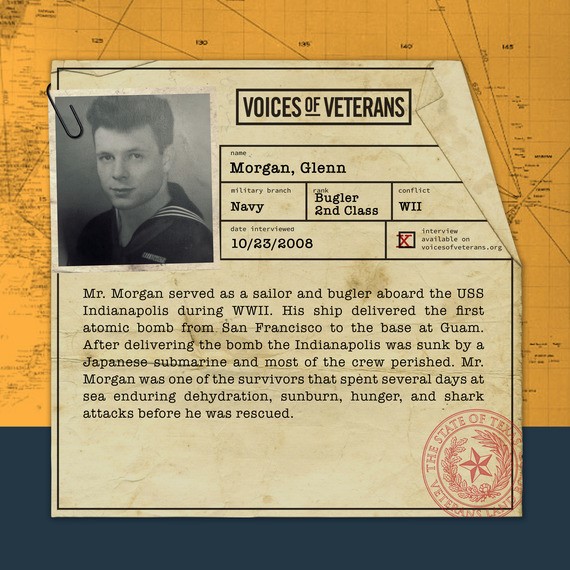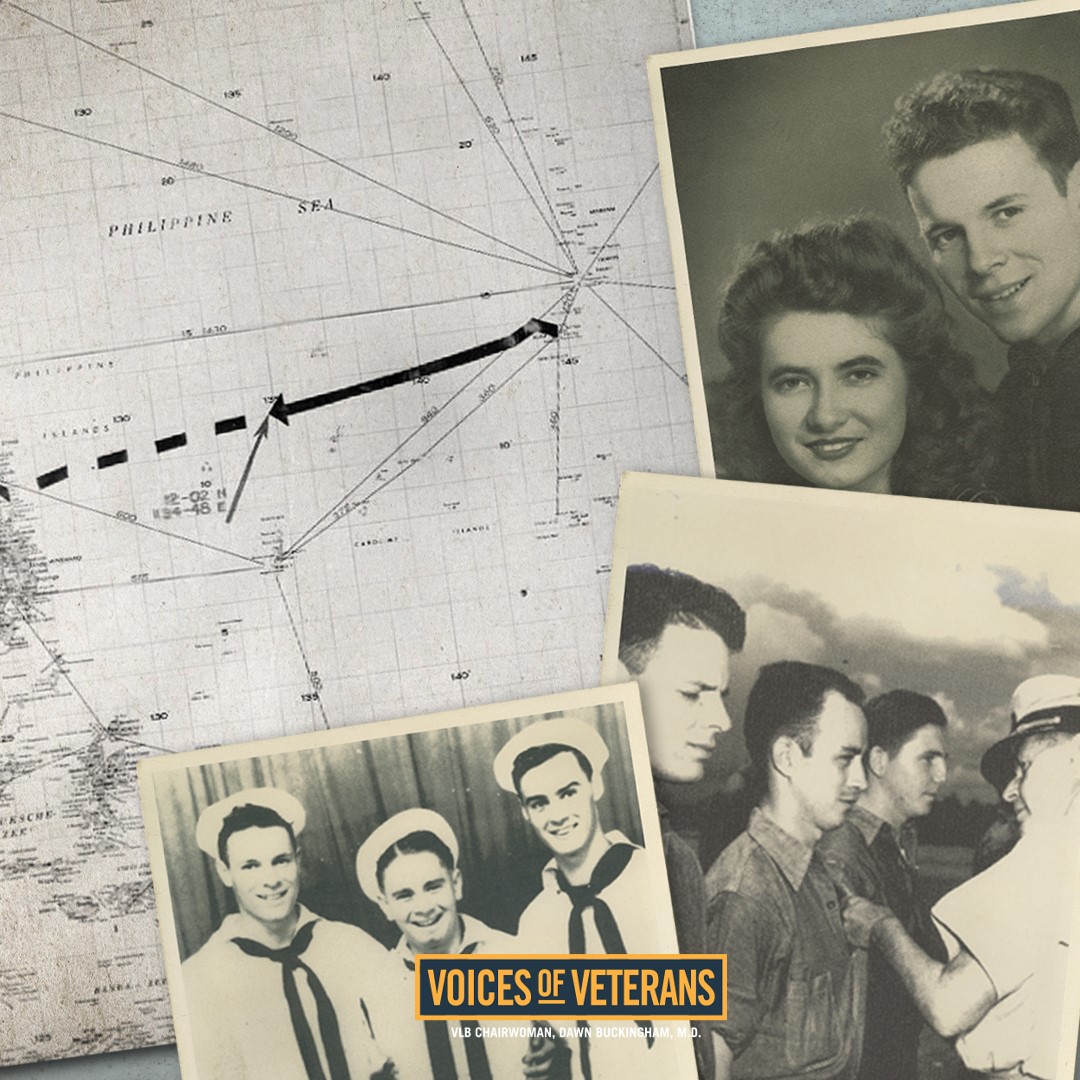Voices of Veterans: Bugler 2nd Class Glenn Morgan Shares His Story of Service with the U.S. Navy Aboard the USS Indianapolis
AUSTIN — Today, Texas Land Commissioner and Veterans Land Board (VLB) Chairwoman Dawn Buckingham, M.D., is proud to introduce the next installment of the series highlighting the VLB's Voices of Veterans oral history program. In this special episode, we highlight the service of Bugler 2nd Class Veteran Glenn Morgan of the U.S. Navy, who sailed aboard the USS Indianapolis and survived the ship's sinking.
Born in Bristow, Oklahoma in 1923 and, by his account, never lived there as his family worked in the oil fields and they moved around a lot. His public education began in Texas but he graduated from high school in Salem, Illinois.
"We migrated around a lot, I guess you could say," Morgan recalled. "From Texas to Kansas to Illinois, we didn't stay long in many places."
Morgan said after high school he started working for Texaco in 1943 and was then drafted about six months after he started working for the gas and oil giant.
"When I was drafted, the draft board didn't even know where I was because my draft board was in Great Bend, Kansas," Morgan recalled.

Morgan said he was ordered to join the Air Corps and was sent an order to take a test but he never received the order in time so he had to wait until he was drafted. While he knew he would get drafted, and when he got his orders, he boarded a train and headed to Chicago.
"Actually, how it happened, I got on the train in Salem, Illinois and there was my good friend and he was being drafted and we went to Chicago," Morgan explained. "As we got up to the Army building, there were a lot of naked fellas going through, what I was told, was a short arm inspection and as I stood there in awe of what was happening, I happened to see a young Naval Officer on the other side of these naked bodies and so I asked them if I could get into the Coast Guard, which means I could stay home."
While Morgan was denied getting into the U.S. Coast Guard, he did end up joining the Navy.
"So, I guess," Morgan said with a laugh, "I never did get drafted. I just joined the Navy instead of the Army."
Morgan said he trained in the Great Lakes area and played the King Cornet and took it with him to boot camp so he would have something to do. Morgan said he would play while in the barracks and his bunkmates suggested he should play in The Head, or restaurant, and while he only took it as a suggestion, that wasn't the entire truth.
"Apparently, they didn't care for my beautiful Cornet tones," Morgan laughed. "I was playing in The Head one night, I was playing Stardust as a matter of fact, and some guy popped in and asked if I was Morgan and I said I was, and he asked me why I wasn't in the Drum and Bugle Corps."
Morgan said he was told if he could get in, it would get him out of a lot of marching. The next morning, Morgan said he went and took the test he was told about and found passing it to be easy since he grew up a Boy Scout.
"While I got out of a lot of marching, I volunteered to do so and went back to the Chief Petty Officer, told him I could play the Snare Drum and so that's what I did. I played the Snare and marched with my old company all because I felt bad," he said about testing into the Drum and Bugle Corps.
In late 1943, Morgan said he was transferred to Valejo, California and dropped them off at a Pier and he said he saw this massive ship, the USS Indianapolis.
"I'd never seen anything like it before, at least up close," Morgan recounted. "As a matter of fact, it looked quite ominous. So, the other bugler with me, his name was Calvin, we walked down, crossed the bow, saluted and stepped down on the quarterdeck and as soon as we set our feet down, our lives were changed forever."

In July 1945, while Morgan was onboard, The USS Indianapolis completed a top-secret high-speed trip to deliver uranium and other components for the first atomic bomb ever used in combat to Tinian Naval Base located on Guam.
"They brought this thing aboard and put in the port hangar and that's all I can really remember about it," Morgan said. "I don't remember seeing them bring the uranium aboard like others have talked about or where they put it. They claimed they welded it to the deck, whether they did or not I don't know, but I walked by that big bomb, well, not every day."
Morgan said they put a detachment of Marines on it and while he heard rumors of others saying they'd laugh and go and sit on it, but he doesn't quite remember that but does remember how big it was.
"This thing was about the size of a van and I remember very distinctly this thing, it was a nice big crate and all the screws on this thing were counter-sunk and sealed with some kind of red sealing wax," Morgan explained. "I thought later, why did they do that, at the time I didn't realize they didn't want anybody prying the thing open."
After unloading the atomic bomb, the USS Indianapolis departed for the Philippines and in the early morning hours of July 30, the ship was torpedoed by the Imperial Japanese Navy submarine I-58.
"I was sound asleep when these things hit," Morgan said of the night the USS Indianapolis was hit by the Japanese. "It more lifted you off the deck than anything else and I looked at my watch right away, it was 10 minutes after midnight and the reason I remember that is because that watch told me how much longer that ship remained afloat."
Morgan said the watch stopped working as soon as he hit the water or shortly after he was in the water, stopping at 12:20 a.m., which indicated the few minutes it took the USS Indianapolis to sink was accurate.
Morgan said he'll never forget the final moments before the USS Indianapolis sank and the strategic shuffling he did to keep himself from getting hurt and bracing for the water as the ship perished at sea.
"The last thing I touched on the USS Indianapolis was the funnel right on the end of that 45mm gun, and I had this feeling of going up this gun but in actuality, it was going down," Morgan said. "I remember I just swam away and I just sat out there and I looked at this thing and watched it stand up on it's nose and it plunged into a mountain of bubbles."
To listen to Navy Veteran Glenn Morgan tell his story, click the button below:
Bugler 2nd Class Glenn Morgan's Story
Veterans can email VoicesofVeterans@glo.texas.gov to tell their stories. Please note that the Veteran must be a resident of Texas at the time of their interview.
Voices of Veterans is a state agency's first Veteran oral history program. It records the stories of Texas Veterans through their time in service and after returning home from combat.
The VLB records interviews with veterans over the phone or in person. Their interviews are then permanently archived in the Office of Veterans Records at the GLO, where they join the historical documents of other Texas heroes such as Sam Houston, Davy Crockett, Jim Bowie, and William Barret Travis.
Veterans' interviews are also available to researchers, historians, genealogists, and the public. These precious records inspire future generations and remind us of our Veterans' sacrifices.
To listen to the over 500 archived stories of Veterans documented through the GLO's Voices of Veterans oral history program, click the button below:
More Press Releases
